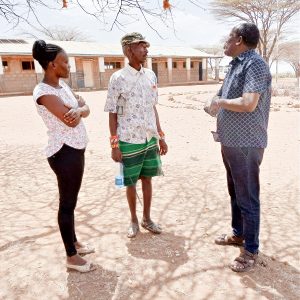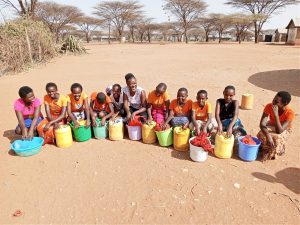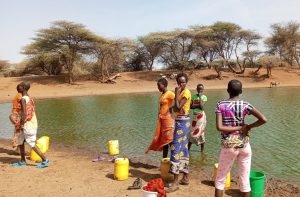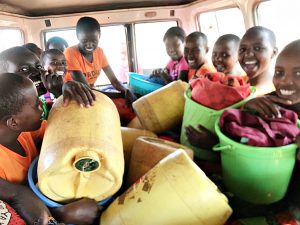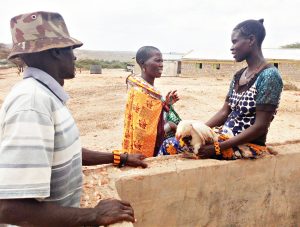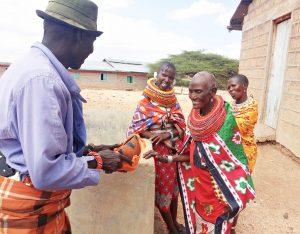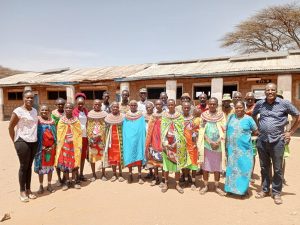We made our first trip to Northwest Kenya this year in February. On our way from Nairobi to Nanyuki (the town at the foot of Mt. Kenya), we noticed the snow on the peak of Mount Kenya is barely visible. However, on our trip from Nanyuki to Rumuruti, we were graced to see Elephants, Giraffes, Rhino’s, Buffalos, and Ostriches among other wild animals. This time round, unlike similar seasons of a few years ago, the weather is very dry. The wildlife has
barely anything to eat as most of the trees in their habitat have dried. The road from Nanyuki to Rumuruti towards Maralal is dustier. On our way from Maralal to Baragoi, we encountered a bus carrying water containers, a signal that the water situation is not very good. The sun is scorching, and one would confuse 11am for 2pm due to the sharpness of the sun.
Upon arrival in Baragoi, there is some tension as a recent incident took away one life of a Samburu man, who was part of the participants of the last training that we conducted in Bendera village late last year. This was in addition to hundreds of herds of cattle that were lost during the same incident. Unfortunately, this incident was a counterattack after an attack that had taken place a few weeks ago. A Turkana man from Nachola village was killed and he left behind a young widow who had a young baby delivered in January this year. The memories of this conflict that took away her husband will remain forever in her mind.
Upon arrival, we took time to console the participants of the training who either lost their dear ones or their herds of animals. Most of these raids are orchestrated by communities beyond front line villages although it is the members of the frontline villages who are left to bear the pain of the counter attacks and revenge.
The story of Mzee Leparsulan
While the Turkana and Samburu community members shared their side of the story on how the protracted conflict has affected both sides of Turkana and Samburu communities, one man by name Leparsulan shared a heartwarming story.
Leparsulan is a Samburu from the village of Bendera. He has three children who have been in the children peace program for three consecutive years. He is also a beneficiary of heifers for peace and goat for peace project organized by Children Peace Initiative Kenya through the support of ifa Zivik and Rotary International. Leparlsulan’s daughter has a friend in Natiti, one of the Turkana villages targeted by the peace project.
Together with his daughter he has participated in family homestay peace activity and has bonded with the Turkana family where his daughter has friends. During the family homestay visits the two families became friends, exchanged contacts, and have maintained communication. Their children visit each other during the weekends and school holiday.
In January this year, a raid took place and the Turkana warriors raided hundreds of Samburu cows and goats. On the day the raid took place, Mzee Leparsulan was grazing near the Turkana territory. It was the only place with pasture as it had been abandoned for several months due to conflict. Mzee Leparsulan had his herd of cattle as well as those of his fellow villagers. They were herding together with his other Samburu colleagues.
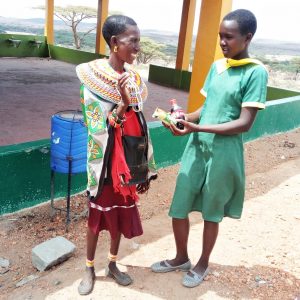
A Samburu woman from Bendera village meets her Turkana ‘daughter’ from Nachola. The girl is a ‘friend for peace’ to her daughter and has participated in CPI Kenya’s program
That day he received a call from a Turkana woman, mother of his daughter’s friend for peace. She enquired where he was and on noticing the danger surrounding the father of her daughter’s friend, told him there is an imminent raid on the Samburu herds by the Turkana warriors and he should vacate from that grazing zone as quickly as he can.
Leparsulan immediately alerted his colleagues and they started driving the animals away from the hostile zone. In less than an hour, the Turkana raided the Samburu herds and took with them cows and goats. Leparsulan’s cows and goats and those of his village mates who were near him were lucky that day. If it was not for that call from a Turkana woman whose child is a friend for peace to Leparsulan’s. He says he would have lost all his livestock that day, not only his but some of his Samburu neighbors too.
Mzee Leparsulan says he will forever remain grateful to his Turkana family friends for the gesture that saved him and his animals. He felt so indebted to his Turkana family friends for peace, that he sent her Kshs 500 ($5) to buy something for her family.
The Mzee’s story is similar to many other stories shared by beneficiaries who have enjoyed the inter community connection created by the children peace program among the Samburu and Turkana communities in Baragoi Sub County. Many lives have been saved and although the situation is still delicate, this is a story of hope.
The Mzee’s experience is a ray of hope and is also not isolated since the sharing of information across the two communities has increased since the inter-community friendship was initiated by children.
The inter-community interactions have continued and gentle actions of kindness continue being expressed by families who have been connected through children and parents’ family pairing activity. Over the weekends and holidays, children from Natiti and Bendera villages have been visiting each other and helping with domestic chores.
Their parents have also been sharing gifts when the children visit. Gifts range from goats, uniforms, calabashes, foodstuffs, money, and confectionaries among other gifts.
The Green Water
In Ngilai village where one of our trainings took place, we were warmly welcomed by the school headteacher. He shared how difficult the situation in the school has become lately. Although the school has a boarding section, there is a shortage of food ration and children skip lunch most of the time.
Water is another challenge. At that time, unfortunately the school was running out of the water for cooking and in a few days’ time he was not sure how they would cope. While we were still conversing with the headteacher, we saw the girls in the boarding section walking with buckets of dirty laundry for cleaning and yellow water containers to go fetch water in a dam nearby. The dam near the school dried up last year due to a prolonged dry spell. The last time the area received reliable rainfall was in April 2021.
The water levels for boreholes have become very low and most of the dams have dried. The nearest dam that is serving the school and the community is 4.5 kilometers away from Ngilai village. The girls were in the company of an elderly school matron who was also carrying her water containers. The sun was hot, and we offered ease their journey and give them a ride to the water pan.
As soon as the girls got in the vehicle they started singing. Beautiful melodic voices. Listening to them, and remembering they only do one meal per day, I wondered where their energies were coming from, or maybe their bodies have adjusted to that reality.
On our way to the water point, we passed other villagers who were also heading to the dam with loads of clothes for laundry and water containers. The dam serves the entire village. Upon arrival, we found so many animals; camels, goats, donkeys, cows, and sheep all at the water point.
Without wasting time, the girls jumped from the car and started quenching their thirst! I watched them drink the water and was taken aback, the water was dirty and green! But this did not stop them from quenching their thirst. This was the first time they were drinking water in almost a week despite the high temperatures, and they could not wait.
As I stood there observing all that was happening, I wondered whether the girls understood the danger that is looming because of drinking green water. When we enquired from them whether they know why the water is green, they seemed so very aware that it’s because the water is stagnant and the many animals from their village are continuously excreting in the dam. Unfortunately, it’s the only water they have, and nobody deserves to drink contaminated water!
While some were drinking the water, others were filling their water containers and others were dusting off and some had already started to do their laundry. After finishing their to-do list at the dam, they took the long-awaited shower, carried water-filled containers, and started a long trek back to school. Three hours later on our way from Ngilai village, we saw the girls halfway through on the journey back to school. They were under a shade taking a rest at the same time waiting for the sun to go down a little bit for it to be cooler for them to finish the remaining journey to school. We gave them some biscuits and proceeded with our journey back to Baragoi town.
Why Our Work Matters
On our way, we encountered a caravan of camels heading to drink water at the dam. Only drought resistant animals can survive the harsh dry weather. The cows and goats, though they are the core of pastoralist livelihood, are gradually becoming weak and are unable to cope with the dry weather. The other girls and the women we found at the dam we saying they hope it will rain before the dam dries off as the animals feeding on it are many and the water related needs for the village are overwhelming.
Children Peace Initiative Kenya has been working in Baragoi since 2019 June implementing various projects supported by Rotary International, Ifa zivik and through collaboration with Advocacy Project who have been sending peace fellows every year to document the work done by CPI Kenya and to help in fundraising via global giving platform.
Over the years, the program has connected 751 Turkana and Samburu families through children’s friends for peace, family twinning, goats and cows for peace shared by Samburu and Turkana families. The community has continued to communicate and sustain the friendship across the two warring communities which is a great incentive for peace.
Although the program implementations had challenges due to covid-19 guidelines, the children and families involved did not allow that year gap to come on the way to their friendship. They took advantage of mobile network and used phones to reach out to each other during the pandemic.
We are confident that the work we are doing in Baragoi will continue bearing more fruits and one day the communities will change the narrative of how the story ends for the Baragoi community in line with peace and conflict.
Posted By Monica Kinyua
Posted Jul 10th, 2022



